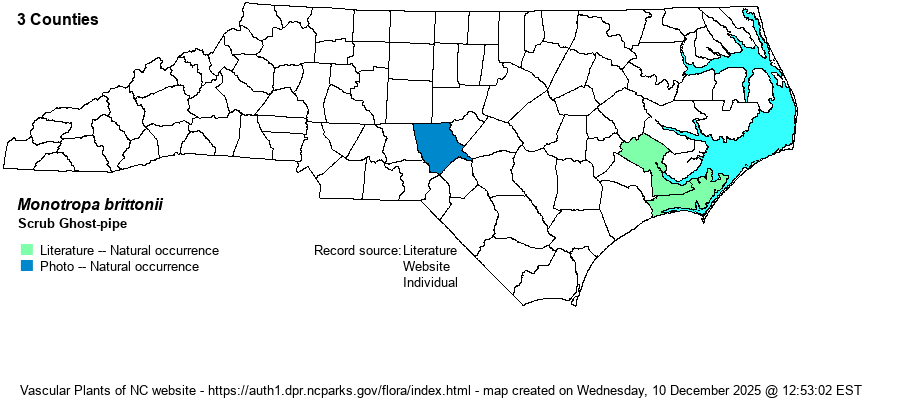| Author | Small | |
| Distribution | Very poorly known, as this taxon -- originally named many decades ago by Small -- has only recently been considered by some taxonomists to be a valid species (See Taxonomic Comments). Believed to be confined to the Coastal Plain, at least north to Carteret County and west to Moore County. Several confirmed photo records are present on iNaturalist, from Carteret, Craven, and Moore counties.
According to Weakley (2022), ranges north at least to eastern NC, south over most of FL, and west to southeastern LA. | |
| Abundance | Very poorly known, and Weakley's (2022) map shows it as "rare", and only in the Coastal Plain; his 2020 map shoed it as "uncommon". It does seem to be scarce in NC, at least in relation to the widespread and rather numerous M. uniflora, but the website editors feel that a State Rank of [S1S2] is warranted now, as is a Watch List (W7) status. The NCNHP followed our recommendations and added this entity to its Watch List in 2022, with a State Rank of S1S2. | |
| Habitat | Almost always in sandy soil of various scrub habitats, in NC including Coastal Sandhill Scrub natural community with Longleaf Pine (Pinus palustris) and probably several oaks (Quercus spp.) as woody associates. Several records are also from maritime forests. Most of the habitat work has been done in FL, and thus more details are needed to clearly outline the primary habitats in NC. However, the very closely related M. uniflora is well known to occur mostly in mesic hardwood or mixed forests. | |
| Phenology | Not certain, but seems to bloom mainly in fall, especially in October, and fruits mainly from October to December. | |
| Identification | See M. uniflora for general appearance. As with that species, it has a single nodding flower; however, in M. brittonii the stem and flower colors tend to be creamy-yellow to orange-yellow (though never deeply colored), to even "red"; M. uniflora is typically white throughout, ranging to pale pink. More detailed, and conclusive, characters listed by Keesling (2020) in her M.S. thesis are: M. brittonii -- "nectaries upturned towards the flower opening; interior surface of flower segments densely pubescent (the margins of the segments strongly ciliate); stamen filaments strongly decreasing in diameter upwards", whereas in M. uniflora -- "nectaries downturned away from the flower opening; interior surface of flower segments glabrous (the margins of the segments sparingly ciliate); stamen filaments nearly isodiametric from base to summit". Thus, you likely need to split open a flower to be certain of the identification. | |
| Taxonomic Comments | Small originally described this taxon, as a species, but almost all subsequent authors lumped it into M. uniflora, until the late 2010's. A few recent references have considered it as valid or perhaps valid, including Weakley (2020). A M.S. thesis by Keesling (2020) provides considerable molecular evidence that these two taxa are apparently distinct species.
| |
| Other Common Name(s) | Southern Ghost-pipe, Scrub Indian-pipe, Scrub Ghost-pipe | |
| State Rank | S1S2 | |
| Global Rank | GNR | |
| State Status | W7 | |
| US Status | | |
| USACE-agcp | | |
| USACE-emp | | |

